
Chapter Four
An Era of Change
1913-1929
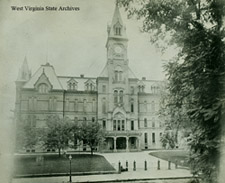
West Virginia Capitol, 1885-1921

Front page, Charleston Mail, March 4, 1913
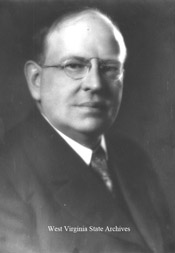
Governor Henry D. Hatfield
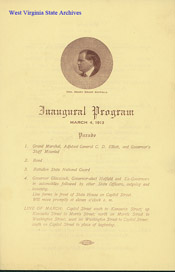
Hatfield's Inaugural Program
|
Beginning with a customary inaugural parade, Henry D. Hatfield became governor of West Virginia on March 4, 1913. The procession, headed by Adjutant General Charles D. Elliott and mounted staff, included the Cog City Band of Charleston, a battalion of the National Guard, and state and city officials. A first for a gubernatorial inauguration, the officials rode in automobiles rather than carriages, Governor Glasscock and Dr. Hatfield riding in the first automobile. A group of Greek residents of Charleston marched at the end of the parade, carrying the national flags of the United States and Greece. The group processed along Capitol Street to Kanawha, east to Morris, north to Washington, and back to the beginning.
Hatfield's inaugural committee had sent out a reported 10,000 invitations and arranged special rates with most rail carriers, and the streets and area surrounding the capitol were filled with thousands of cheering spectators. Once the processional party reached the platform, the formal part of the inauguration was conducted, with invocation, remarks by Governor Glasscock and former governors MacCorkle, White, and Fleming, Hatfield's inaugural address, and the oath of office, administered by Judge George Poffenbarger of the Supreme Court. An informal reception followed.
| |
|
"Shortly after the noon hour today, in front of the Capitol, in the presence of perhaps the largest crowd that had ever assembled on a similar occasion, and in spite of cloudy and murky weather, Dr. Henry Drury Hatfield, of McDowell county, was inaugurated the fourteenth governor of West Virginia. The scene had a gala setting. On the stand, which had the decorated capitol walls as a background, there was an array of chivalry and beauty, gay in color and harmony, which was relieved only by the more sober costumes of the state officials and judges of the supreme court. The stand was reserved for the state officials, the ex-governors, the governor's staff and former members of former staffs, the members of the supreme court of appeals, and lastly but not the least in number, importance or evidence, the ladies of the officials and their friends." - Charleston Mail, March 4, 1913 |
|
""His reception all along the line . . . was such as to show that the people of this State highly respect him, and must have resembled in a way the tri[u]mphal march of old Julius Caesar to Rome following a victorious campaign, and Napoleon into Paris following a conquest of the armies of many nations." - Charleston Mail, March 4, 1913 |
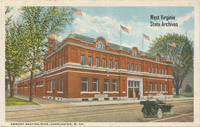
1913 Armory. Postcard Collection
Hatfield's inaugural activities provided another first: the inaugural ball, formal reception, and supper were not held in the capitol building. Instead, they were held in the recently constructed armory building that stood less than a block away. H. Beckenstein provided an orchestra of local musicians for the evening, which was trumpeted by the Charleston Mail as a "brilliant inaugural success."
|
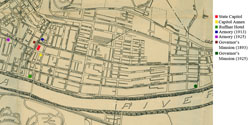
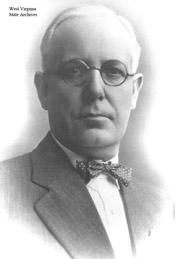
Governor John J. Cornwell |
In 1917, for only the second time since West Virginia became a state, the date when the new governor was to take office fell on a Sunday. Although the record for Governor Matthew's inauguration in 1877 gives no indication that he took the oath of office prior to the formal ceremonies on March 5, John J. Cornwell took the his oath at 12:08 p.m. on March 4, 1917, in the parlor of the Ruffner Hotel. A small group of people, including his wife Edna and mother Mary, witnessed the ceremony. |
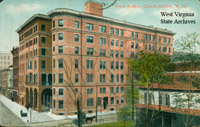
Ruffner Hotel.
Postcard Collection |
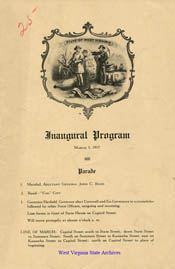
Inaugural Program for Governor Cornwell.
Sc2003-136 |
Plans for Cornwell's formal inauguration on March 5 included a parade and addresses from the five living former governors (Fleming, MacCorkle, Atkinson, White, and Glasscock). However, two days of snow and rain forced cancellation of the parade. The speakers' stand in front of the capitol was covered with more than six inches of snow, and ceremonies were moved to the House of Delegates. Former governor Aretas Brooks Fleming was unable to attend due to ill health. Two of the incoming state officials were ill and also unable to attend: State Treasurer William S. Johnson was in the hospital and had taken his oath on Saturday, while Attorney General Edwin T. England was sick at the Kanawha Hotel.
William MacCorkle, the last Democrat to occupy the governor's office before Cornwell, served as master of ceremonies for the occasion. Cornwell gave his inaugural address after taking the oath of office a second time. Other officials were sworn in following Cornwell's speech, and an informal reception was held in the House. The armory once again served as the venue for the formal reception and ball in the evening. Harry Froelich provided the orchestra. A buffet supper was served at midnight. |
John J. Cornwell's inauguration was the last held in the building that had served as state capitol since 1885.
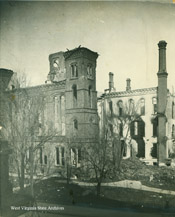
Ruins of West Virginia's capitol, 1921
|
"I want to express my deep regret over the burning of the state capitol. On the walls of the capitol hung portraits of the governors of the state.
Outstanding among these was one portrait particularly beautiful. The picture itself was attractively finished. The picture was beautiful--not the original. The subject was the youngest governor ever inducted into office, but if the artist would paint his picture today, he would have only to use white paint instead of red.
These portraits were destroyed in the fire. The handsomest picture was lost--a thing of beauty gone."
- Ex-governor A. B. White's remarks at Morgan's inauguration on MacCorkle's portrait. Charleston Gazette, March 5, 1921 |
|
On January 3, 1921, two months before Ephraim F. Morgan would be inaugurated as the state's sixteenth governor, West Virginia's capitol burned. Morgan's inauguration on March 4 had to be held elsewhere, and the armory was used for nearly all the inaugural activities.

Invitation to Morgan's inauguration
 |

Governor Ephraim F. Morgan

Morgan's Inaugural Program. Sc2003-0136
| |

1913 Armory. Postcard Collection |
On March 4, approximately 4,000 people congregated inside the armory for Morgan's inauguration. The ceiling was covered with blue satin with gold stars; flags and streamers interwoven with rhododendron decorated the room. The Rev. D. L. Ash of Huntington gave the invocation, and Frank Kincheloe, secretary of the Board of Control and a local musician, led the singing of "America." As Judge Harold Ritz administered the oath to Morgan, "moving picture men" took pictures. Plans had called for ex-governors Fleming, Atkinson, MacCorkle, Glasscock, and Hatfield to participate, but only MacCorkle was present. Former governor Albert B. White served as master of ceremonies, and Governor Cornwell introduced his successor. After Ephraim Morgan delivered his inaugural address, and the formalities concluded, he and his wife Alma walked to the steps of the governor's mansion, where their pictures were taken by photographers. An informal reception was held at the Ruffner Hotel. The formal reception and ball were held at the armory that evening. |
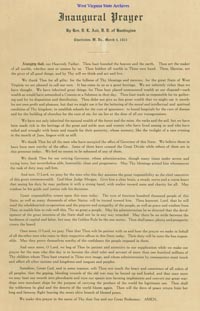
Inaugural prayer for Morgan's inauguration.
Morgan Collection |
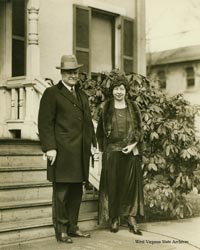
Governor Ephraim F. Morgan and wife Alma
in front of the governor's mansion.
Possibly taken on the day of
his inauguration. Morgan Collection |

Invitation to the inaugural ball |

Governor Howard M. Gore

Inaugural program
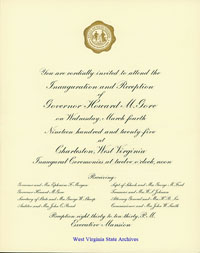
Invitation to Gore's inauguration
|
|
The Capitol Annex, across Lee Street from the burned capitol building, provided the backdrop for the inauguration of Howard Mason Gore as governor on March 4, 1925. Gore arrived by train from Washington, DC, in the morning and enjoyed a brief rest at the Kanawha Hotel before starting the day's activities. At about 11:30 a.m., a parade began about two miles away from the annex, at the new capitol site, and processed along Kanawha Street to Capitol, then to Lee, along a route packed with crowds. Preceding the automobiles carrying various officials was the cadet band from West Virginia University, and following were national guardsmen, veterans of the Spanish American and World wars, civic and business clubs, and municipal and 150th Infantry bands. At the annex, the cadet band left the parade and took position beside the reviewing stand, from which the band played for the other groups as they marched by, except the municipal band and regimental band of the 150th Infantry. The latter was scheduled to play "The Old Gray Mare" at that point in the parade. |
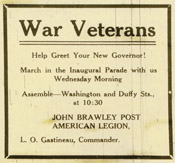
Notice to Veterans
Charleston Gazette, March 4, 1925 |
|
"Every one turned out to the parade. Capitol street bore a resemblance to circus day. People came down town early in the forenoon and lined up on the curb a full hour before the time scheduled for the parade to come by. The state house offices were closed and the United Fuel Gas company office force took a holiday.
Virtually every one who had a flag responded to Mayor Wertz's appeal and put it up. Even the street cars bore flags. For the past few days the American Legion had been busy drilling the holes in the sidewalks for the last of the curb flag system of decoration installed by it and virtually every merchant had his flags out." - Charleston Gazette, March 5, 1925 |
|
"The capitol building and the old governor's mansion on Capitol street were generously covered with long red, white, and blue streaming banners, and looking down Capitol street one's view was greeted with a lane of bright colors. In front of the Capitol annex on State street where the inauguration ceremonies were held, a long pole wound round with the tri-color, was the central point of the platform's decorations. . . .
Many merchants, amid the drapings of Old Glory, had signs and banners bearing a message of welcome to the new executive, while several cars and store windows were placarded with last fall's "Gore-for-Governor" signs." - Charleston Gazette, March 5, 1925 |
On the speakers stand at the annex, a congratulatory telegram from President Calvin Coolidge was read, the Rev. W. B. King of Central Methodist Episcopal Church gave the invocation, Frank Kincheloe led the singing of "America," and Governor Morgan spoke. Gore gave his inaugural address, his voice carried across the crowd by a Bell public address sytem. After he finished speaking, he was presented with a basket of flowers from people with whom he had worked in Washington, and Judge Frank Lively administered the oath of office. An open-air reception followed.
|

Capitol Annex
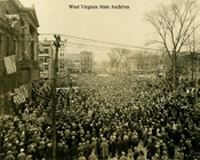
Scene from Gore's inauguration.
The Capitol Annex is at left.
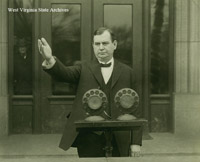
Howard Gore delivering his inaugural address

Howard Gore's oath of office.
Ar1839
|
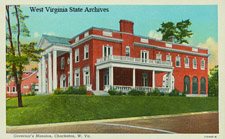
Early view of the governor's mansion.
Postcard Collection
|
Between 8:30 and 10:30 in the evening, a formal reception was held in the new executive mansion, the first time the new building formally opened to guests, and visitors both greeted the new governor and toured the house. Activities moved to the new state armory on Goshorn and State (Lee) streets at 10:30, where the inaugural ball was held. The Antlers Orchestra of Charleston and Billy Zellers and his Orchestra of Clarksburg, Gore's state residence, provided music for the crowd that packed the building, playing 39 numbers before the night ended. |
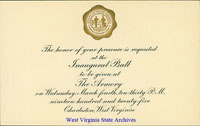
Invitation to the inaugural ball |

Inaugural ball dance card.
Chapman Revercomb Collection
|
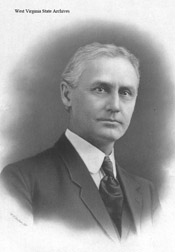
Governor William G. Conley |
Inaugural events moved yet again in 1929, when William G. Conley became governor. Plans called for Conley to be the first governor inaugurated on the grounds of the new, partially constructed capitol, about two miles east of the old capitol, and a platform was erected on the northwest corner of the first section facing Duffy Street for that purpose. However, rain caused a change in plans. The route for the parade, originally intended to end up at the new capitol, also changed, ending up at the armory on State Street instead, where ceremonies had been moved. Wheeling businessman and owner of the Wheeling Intelligencer H.C. Ogden served as master of ceremonies, and Senate chaplain, the Rev. W. B. King, gave the invocation. The West Virginia University Cadet Band and Charleston Municipal Band played, and Frank Kincheloe led the singing of "America." Following an introduction by Governor Gore, Conley gave his inaugural address and took the oath, administered by Homer Woods. The Ravenswood High School Band was scheduled to perform as well. |
The formalities concluded, Gov. Conley and other officials and prominent men attended a luncheon given at the Scottish Rite temple (the building that had served as the armory in 1913) by the Rotary Club. Conley was the first Rotarian to become governor. Meanwhile, Mrs. Conley attended a luncheon at the governor's mansion hosted by the inaugural committee. In the evening, a formal reception was held in the governor's mansion, after which the inaugural ball was held in the State Street armory, which was decorated in blue and yellow. Jacob Beckenstein led two orchestras. The ball brought a mix of old and new, as both formal and informal wear was present, and the music included not only traditional ballroom numbers but also jazz.
|

Cover to Inaugural Program
|
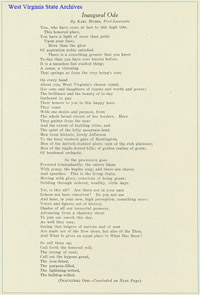
Inaugural Ode by Karl Myers
from Inaugural Program |

Political cartoon,
Charleston Gazette, March 10, 1929
|
|



































